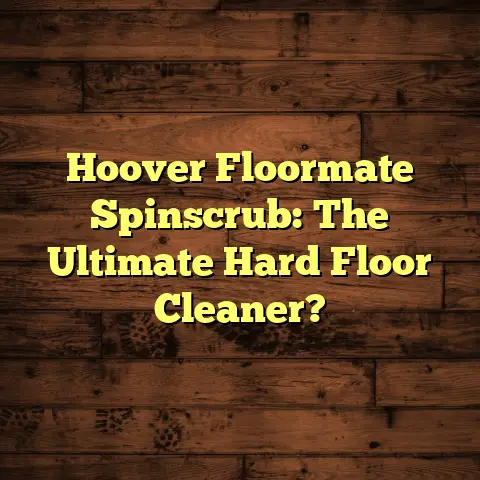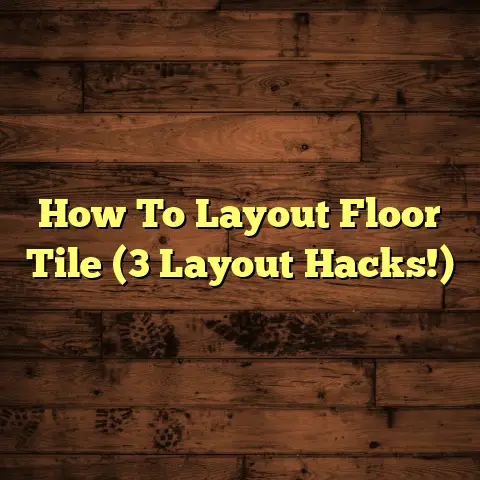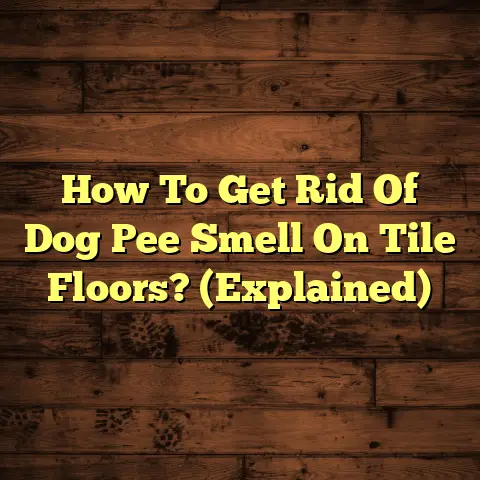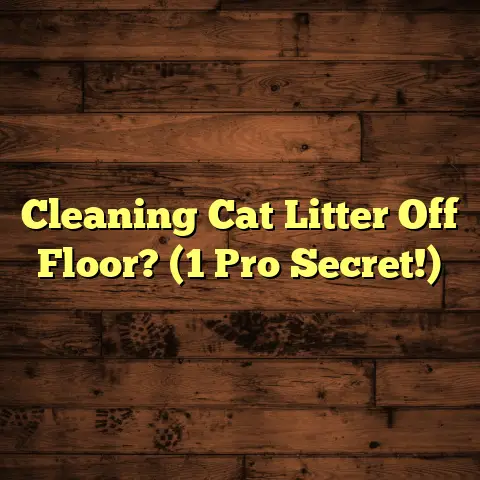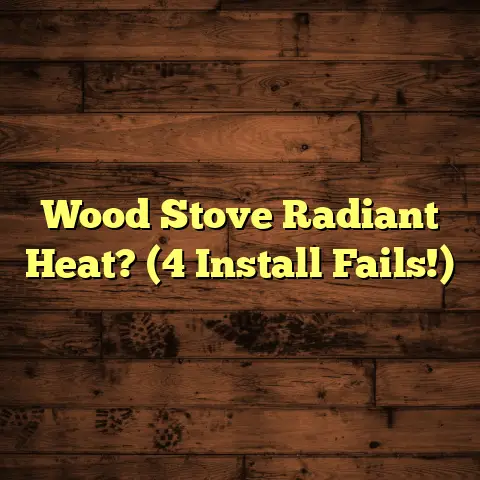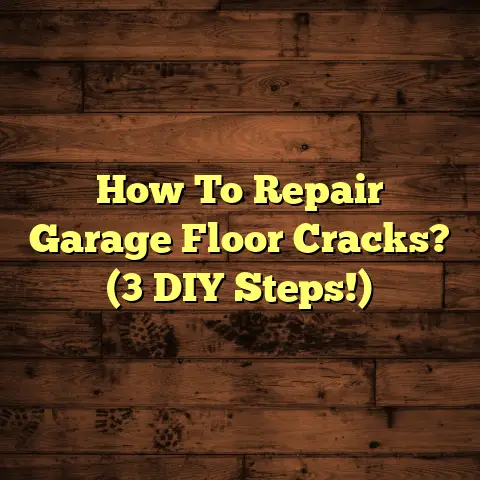White Spots On Hardwood? (1 Hr Fix, Act Now!)
Introduction: The Luxury of Hardwood Flooring
There’s just something about hardwood, isn’t there? The rich, warm tones, the elegant grain patterns… it instantly elevates any space.
I’ve seen it time and again, walking into homes transformed by the sheer beauty of a well-maintained hardwood floor. Whether it’s the classic charm of oak, the sleek sophistication of maple, the warm embrace of cherry, or the deep, luxurious tones of walnut, hardwood speaks volumes.
It’s a statement of quality, a touch of timelessness, and an investment in your home’s aesthetic appeal. A well-cared-for hardwood floor isn’t just flooring; it’s a focal point, a conversation starter, and a source of daily pleasure.
But let’s be real. Hardwood, as gorgeous as it is, isn’t invincible. Life happens, and sometimes, those beautiful surfaces can develop unwelcome guests: white spots.
These pesky marks can detract from the overall beauty of your floors, and if left unaddressed, they can potentially lead to more significant problems. That’s why I’m here to share my expertise and help you tackle this issue head-on.
I’m going to walk you through understanding what causes these spots, why it’s crucial to act fast, and, most importantly, how you can often fix them yourself in just about an hour! So, let’s dive in and get those floors looking their best again.
Section 1: Understanding the Problem of White Spots
on Hardwood Flooring
Okay, so you’ve noticed those dreaded white spots. Don’t panic! Let’s figure out what’s going on.
1.1 What Causes White Spots?
Think of your hardwood finish as a protective shield. It’s there to guard the wood underneath, but it’s not impenetrable. White spots are often a sign that this shield has been compromised. The most common culprits?
-
Moisture Damage: This is probably the biggest offender. Think of a spilled glass of water left unattended, a damp mop, or even high humidity. When moisture penetrates the finish, it can get trapped, creating those cloudy white marks.
I’ve seen this happen countless times. A client once had a beautiful oak floor ruined by a leaky houseplant! It’s all about preventing moisture from sitting on the surface for too long.
According to the National Wood Flooring Association (NWFA), excessive moisture is the leading cause of finish problems in hardwood floors.
-
Heat Exposure: Hot items placed directly on the floor, like a hot pan or a curling iron, can also cause white spots. The heat can damage the finish, leading to discoloration.
Always use trivets or heat-resistant mats!
-
Improper Cleaning Products: This is a mistake I see all the time. Using harsh chemicals or abrasive cleaners can strip the finish, making it more vulnerable to damage and those telltale white spots.
Stick to pH-neutral cleaners specifically designed for hardwood floors. I’ll give you some recommendations later.
-
Finish Type: Some finishes are more susceptible to white spots than others. For example, polyurethane finishes tend to be more durable and water-resistant than wax finishes.
If you have an older wax finish, you might find yourself dealing with white spots more frequently.
-
Environmental Factors: Believe it or not, your local climate can play a role. Areas with high humidity or extreme temperature fluctuations can put extra stress on your hardwood floors.
1.2 Identifying White Spots
Not all white spots are created equal. They can vary in appearance depending on the cause and severity of the damage. Here’s what to look for:
-
Light Discoloration: These are usually faint, cloudy marks that appear on the surface of the finish. They might be barely noticeable at first but can become more prominent over time.
-
Opaque White Rings: These are often caused by moisture from cups or glasses. They’re usually circular in shape and have a more defined edge.
-
Severe Staining: In more severe cases, the white spots can be quite large and deeply embedded in the finish. These might require more extensive repairs.
Visual Aid: Imagine a freshly waxed car. If water sits on the surface too long, you’ll see water spots. White spots on hardwood are similar, but they’re affecting the floor’s finish.
Pro Tip: Use a flashlight held at an angle to help you spot these imperfections. The light will highlight any unevenness or discoloration on the surface.
Section 2: The Importance of Quick Action
So, you’ve identified those pesky white spots. Now what? Don’t ignore them! Here’s why acting quickly is crucial.
2.1 Why You Should Act Now
Think of it like a small leak in your roof. If you catch it early, it’s a relatively easy fix. But if you let it go, it can lead to major water damage, rot, and costly repairs. White spots on your hardwood are similar.
-
Preventing Further Damage: The longer you leave white spots untreated, the more likely they are to worsen. Moisture can continue to penetrate the finish, causing more extensive damage to the wood underneath.
-
Preserving Beauty: Let’s face it, those white spots are unsightly! Addressing them promptly will help restore the beauty of your floors and keep them looking their best.
-
Maintaining Home Value: Hardwood floors are a major selling point for any home. Neglecting their care can diminish your home’s value.
-
Saving Money: Addressing white spots early can often prevent the need for more expensive repairs down the road, like refinishing the entire floor.
2.2 Understanding the Urgency
Sometimes, white spots are just a cosmetic issue. But other times, they can be an early warning sign of something more serious.
-
Water Damage: White spots could indicate that water is seeping into the subfloor. This can lead to mold growth, structural damage, and health problems.
I once had a client who ignored a small white spot near their refrigerator. Turns out, there was a slow leak in the ice maker line, and the water had been seeping under the floor for months! The damage was extensive and costly to repair.
-
Mold Growth: Where there’s moisture, there’s a risk of mold. Mold can cause allergic reactions, respiratory problems, and other health issues.
Compelling Language: Think of your hardwood floors as a living, breathing part of your home. They need care and attention to thrive. Ignoring white spots is like ignoring a cry for help.
Urgency: Don’t wait until those little white spots turn into a full-blown disaster! Take action now to protect your investment and ensure the health of your home.
Section 3: The 1-Hour Fix for White Spots
Alright, let’s get down to business! I’m going to walk you through a simple, effective method for fixing those white spots yourself. This method works best for relatively new white spots. Older, deeper stains might require professional help.
3.1 Gathering Your Supplies
Before you start, gather everything you’ll need. This will save you time and frustration.
-
Soft Cloths: You’ll need a few clean, lint-free cloths. Microfiber cloths are ideal.
-
Wood Floor Cleaner: Use a pH-neutral cleaner specifically designed for hardwood floors. Avoid harsh chemicals or abrasive cleaners.
Recommendation: Bona Hardwood Floor Cleaner is a popular and effective option.
-
Mineral Spirits: This is a mild solvent that can help remove trapped moisture and restore the finish.
Safety Precautions: Wear gloves and work in a well-ventilated area when using mineral spirits.
-
Hair Dryer: This will help to gently warm the area and draw out moisture.
-
Furniture Polish or Restorative Finish (Optional): If the mineral spirits remove some of the shine, you might want to apply a furniture polish or restorative finish to blend the area with the rest of the floor.
Eco-Friendly Options: Look for plant-based or low-VOC (volatile organic compound) options.
Where to Find Materials: You can find these materials at most hardware stores, home improvement centers, or online retailers.
3.2 Step-by-Step Instructions
Okay, here’s the step-by-step process. Remember to work carefully and test in an inconspicuous area first to ensure the products don’t damage your finish.
Step 1: Cleaning the Area
- Use a soft cloth and your wood floor cleaner to thoroughly clean the affected area. This will remove any dirt, dust, or debris that could interfere with the repair.
- Allow the area to dry completely before proceeding.
Step 2: Applying Heat
- Set your hair dryer to a low setting and gently warm the affected area for several minutes. Hold the hair dryer about 6-8 inches away from the floor to avoid overheating. The goal is to gently draw out any trapped moisture.
Step 3: Applying Mineral Spirits
- Dampen a clean cloth with mineral spirits. Don’t saturate the cloth; you just want it slightly damp.
- Gently rub the affected area with the damp cloth, using a circular motion. Apply light pressure and avoid rubbing too vigorously.
- Allow the mineral spirits to sit on the surface for a few minutes to penetrate the finish.
Step 4: Buffing the Spot
- Use a clean, dry cloth to buff the area. Again, use a circular motion and apply light pressure. The goal is to restore the shine and blend the treated area with the surrounding finish.
Step 5: Reapplying Finish (If Necessary)
- If the mineral spirits removed some of the shine, you can apply a furniture polish or restorative finish to the area. Follow the manufacturer’s instructions carefully.
- Apply a small amount of the product to a clean cloth and gently rub it into the treated area.
- Buff the area with a clean, dry cloth to blend the finish.
3.3 Before and After: The Transformation
Okay, this is where the magic happens! I always encourage my clients to take before and after photos. It’s incredibly satisfying to see the transformation and know that you’ve successfully restored your floors.
Testimonial: “I had a nasty white ring on my coffee table from a spilled drink. I followed these steps, and I couldn’t believe how easily it came out! My table looks brand new again!” – Sarah M.
Pro Tip: If the white spot persists after trying this method, it might be a sign of more serious damage. In that case, it’s best to consult with a professional flooring contractor.
Section 4: Preventing Future White Spots
Okay, you’ve fixed the problem. Now, let’s talk about how to prevent those pesky white spots from coming back. Prevention is always better (and cheaper!) than cure.
4.1 Maintenance Tips
- Regular Cleaning: Sweep or vacuum your hardwood floors regularly to remove dirt, dust, and debris. This will prevent scratches and keep your floors looking their best.
- Avoid Moisture Exposure: Wipe up spills immediately! Don’t let water or other liquids sit on the surface of your floors.
- Use Floor Protectors: Place felt pads under furniture legs to prevent scratches and dents.
- Choose the Right Cleaning Products: As I mentioned earlier, stick to pH-neutral cleaners specifically designed for hardwood floors. Avoid harsh chemicals or abrasive cleaners.
- Control Humidity: Maintain a consistent humidity level in your home. High humidity can cause wood to swell and warp, while low humidity can cause it to shrink and crack. A dehumidifier or humidifier can help.
4.2 Seasonal Care
Hardwood floors can be affected by seasonal changes. Here’s what you need to know:
- Winter: In the winter, the air tends to be drier, which can cause hardwood floors to shrink. Use a humidifier to maintain a consistent humidity level.
- Summer: In the summer, the air tends to be more humid, which can cause hardwood floors to swell. Use a dehumidifier to maintain a consistent humidity level.
- Spring and Fall: During these transitional seasons, pay close attention to humidity levels and adjust your cleaning and maintenance routine as needed.
Conclusion: Emphasizing the Beauty of Your Hardwood Floors
There you have it! A comprehensive guide to understanding, fixing, and preventing white spots on your hardwood floors. Remember, your hardwood floors are an investment in luxury and beauty. With a little care and attention, they can last for generations.
Don’t be discouraged by those occasional white spots. They’re a common issue, and often, they can be easily fixed with a little elbow grease and the right techniques.
Take action now if you notice any white spots on your floors. The sooner you address the problem, the better. And remember to embrace regular maintenance practices to keep your floors looking stunning for years to come.
With a little effort, you can ensure that your hardwood floors remain a symbol of elegance and beauty in your home. Now go get those floors sparkling!
